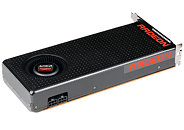- Joined
- Oct 9, 2007
- Messages
- 47,670 (7.43/day)
- Location
- Dublin, Ireland
| System Name | RBMK-1000 |
|---|---|
| Processor | AMD Ryzen 7 5700G |
| Motherboard | Gigabyte B550 AORUS Elite V2 |
| Cooling | DeepCool Gammax L240 V2 |
| Memory | 2x 16GB DDR4-3200 |
| Video Card(s) | Galax RTX 4070 Ti EX |
| Storage | Samsung 990 1TB |
| Display(s) | BenQ 1440p 60 Hz 27-inch |
| Case | Corsair Carbide 100R |
| Audio Device(s) | ASUS SupremeFX S1220A |
| Power Supply | Cooler Master MWE Gold 650W |
| Mouse | ASUS ROG Strix Impact |
| Keyboard | Gamdias Hermes E2 |
| Software | Windows 11 Pro |
AMD announced the Radeon R9 380X graphics card. Positioned between the Radeon R9 380 and the R9 390, this card starts at US $229, and takes advantage of a huge gap in NVIDIA's lineup, between the GeForce GTX 960 ($190) and the GTX 970 ($319). Based on the 28 nm "Antigua" ("Tonga") silicon, this SKU features the full complement of the chip's 32 Graphics CoreNext (GCN) compute units, amounting to 2,048 stream processors. It also features 128 TMUs, 32 ROPs, and a 256-bit wide GDDR5 memory interface, holding 4 GB of memory. The core is clocked at 970 MHz, and the memory at 5.70 GHz (GDDR5-effective), amounting to a memory bandwidth of 182 GB/s.

View at TechPowerUp Main Site

View at TechPowerUp Main Site




